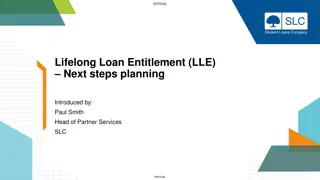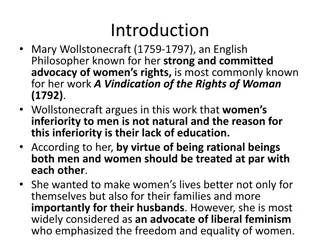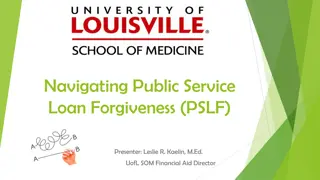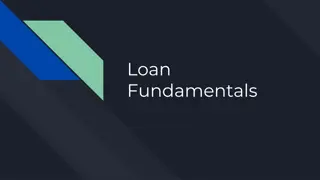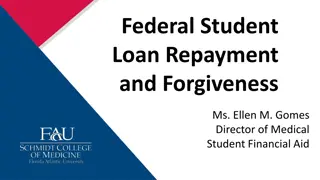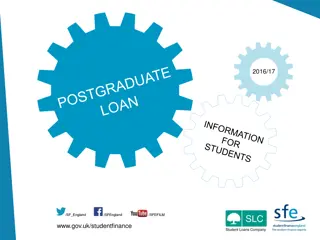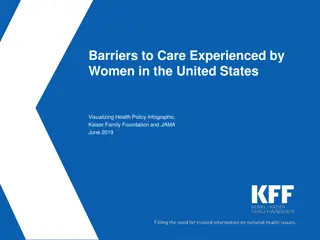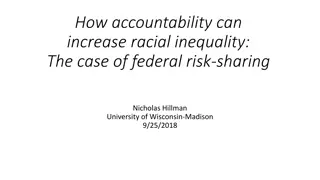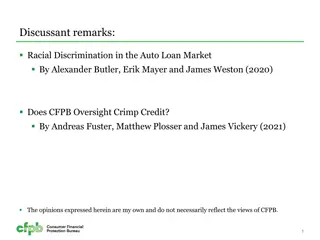Addressing Student Loan Challenges Faced by Women
Women face unique challenges in student loan debt, with higher enrollment rates but lower incomes exacerbating the burden. This program sheds light on the disparities, impacts, and solutions for women navigating student loans.
Download Presentation

Please find below an Image/Link to download the presentation.
The content on the website is provided AS IS for your information and personal use only. It may not be sold, licensed, or shared on other websites without obtaining consent from the author.If you encounter any issues during the download, it is possible that the publisher has removed the file from their server.
You are allowed to download the files provided on this website for personal or commercial use, subject to the condition that they are used lawfully. All files are the property of their respective owners.
The content on the website is provided AS IS for your information and personal use only. It may not be sold, licensed, or shared on other websites without obtaining consent from the author.
E N D
Presentation Transcript
PROGRAM SPONSORS (Direction: Insert information about the AAUW branch(es) or any other sponsors of the program; please include AAUW-PA as one of the sponsors)
WOMEN AND STUDENT LOANS Women are enrolling in college at higher rates than ever before The price of college, however, has increased while incomes haven t
WOMEN AND STUDENT LOANS Student loans are filling in the gap between tuition and income: Americans owe $1.3 trillion in student loan debt. Women owe almost two-thirds of the total US student loan debt ($800 billion) because they take on larger loans and have lower incomes with which to pay off debt
How We Arrived Here
Undergraduate Enrollment at U.S. Colleges and Universities by Type of Institution, 1970 2014 Source: U.S. Department of Education 2016. Note: U.S. Department of Education lacks data from 1971 74, 1976 79, and 1988 89.
Relative Changes in Price of College Attendance and Median Household Income, 19762014 Sources: U.S. Department of Education (2016), U.S. Census Bureau (2016). Note: Cost of attendance and median income are both expressed in constant 2015 dollars, adjusted by the Consumer Price Index.
STUDENT LOANS Student loans are a common strategy for financing college. Student loans are Guaranteed by Federal government, or Made directly by the Department of Education, or Private Loans (banks, etc.) Federal and private student loans are governed by laws that make it difficult to discharge student loans through bankruptcy.
Who Borrows and How Much?
Mean Cumulative Debt for Students Graduating with a Bachelor's Degree by Gender and Race, 2011 12 Source: AAUW analysis of U.S. Department of Education, Institute of Education Sciences, National Center for Education Statistics, National Postsecondary Student Aid Study 2012 data.
FINANCIAL AID SAMPLE FAMILY BILL Cost of Attendance $65K Expected Family Contribution $30K Need $35K Scholarships/Grants $18K Unmet Need (Gap) $17K Family Bill ($30K + $17K) $47K
FINANCIAL AID PAY UNMET NEED 1. Parent PLUS loans (federal government loans made to Parents) Private Loans 2. After 4 years, student may have as much as $100K debt That s $1,100 per month for 10 years
TYPE OF STUDENT ENROLLMENT - DEBT Americans attend several categories of institutions Public, not-for-profit more affordable but common for students to take on some loans to afford Private significantly more expensive, students take on larger loans to afford For-profit Students take on high amount of debt, often do not complete degree
Average Annual Loans by Degree Level and Gender, 201112 Source: AAUW analysis of U.S. Department of Education, Institute of Education Sciences, National Center for Education Statistics, National Postsecondary Student Aid Study 2012 data.
The Long Road Out of Debt
STUDENT LOAN REPAYMENT The standard plan 10 years of flat payments. Income-driven repayment (IDR) options account for a borrower s income and offer longer schedules for repayment. Federal loans may be eligible for debt forgiveness. Failure to make payments may result in default (debt more difficult to repay, harms personal credit ratings, borrower ineligible for future student aid).
STUDENTS WHO DONT GRADUATE Worst-of-both-worlds outcome of debt payments without a degree to increase a student s income. Students who don t graduate are much more likely to default on their loans. Less likely that these students will ever be able to receive a future loan and re-enroll in college.
Percent of College Graduates in Loan Default 4 Years after College by Race and Gender Note: The sample size for Asian graduates in default was inadequate to allow for a gender breakdown within that category. Source: AAUW analysis of U.S. Department of Education, Institute of Education Sciences, National Center for Education Statistics, Baccalaureate and Beyond Longitudinal Study 2008/12 data.
Percent of Single Parent College Graduates in Loan Default 4 Years after College 71% of student parents are mothers Of these 43% are single mothers (IWPR #C424) Source: AAUW analysis of U.S. Department of Education, Institute of Education Sciences, National Center for Education Statistics, Baccalaureate and Beyond Longitudinal Study 2008/12 data.
Conclusions and Recommendations
WOMEN ARE BURDENED BY STUDENT DEBT 56% of U.S. college students are women (2016). AAUW estimates that women take on 60% of initial student loan debt. AAUW estimates that women hold 64% of current student loan debt. Women hold about $830 billion of the estimated $1.3 trillion in student loan debt in the United States.
IS COLLEGE WORTH IT? Yes. College degrees are reliably associated with lower unemployment, higher wages, and better outcomes. But student debt can change the equation, especially for women and people of color, who have lower incomes after college. For a college education to remain an engine for economic security and mobility, it must not require a debt burden that many will find difficult to repay.
RECOMMENDATION 1 Support strong state and federal funding of higher education Tuition rates have increased dramatically but state and federal support have stagnated. Rising college costs endanger access to higher education, particularly for those who have the most to gain from a college degree. As tuition and other costs of enrollment continue to increase, it will be difficult for students to avoid taking on debt. AAUW endorses efforts to maintain affordable public higher education in the United States
RECOMMENDATION 2 Fully fund and expand Pell grants for low-income students Pell grants are a federal subsidy based on financial need. Pell grants should be mandatory and not subject to annual funding disagreements in Congress. Increase amount annually to match tuition increases. Address the needs of non-traditional students by allowing more than one grant in a school year. AAUW supports protecting and strengthening Pell Grants
RECOMMENDATION 3 Address non-tuition costs allowing students to complete college rather than dropping out Affordable childcare for student parents on campus Aid eligible students in accessing federal and state benefits for food and housing Provide food banks on campus AAUW supports reauthorization and fully funding CCAMPIS (Child Care Access Means Parents in Schools) program
RECOMMENDATION 4 Expand repayment approaches to reflect reality Customize loan repayments to reflect economic circumstances (income-driven repayment [IDR]) Make it easier to enroll in IDR programs Make refinancing possible for both federal and private loans Make private student loans dischargeable in bankruptcy AAUW supports making student loans more easily discharged through bankruptcy
RECOMMENDATION 5 Fight to eliminate the pay gaps in gender and race Cover all categories of employees (federal, public, private) Prohibit retaliation to those who inquire about or disclose their wages Discard salary history as a determinant of future pay AAUW supports Pennsylvania HB1243
RECOMMENDATION 5 - Continued Fight to eliminate the pay gaps in gender and race Clarify employer defenses that are job related, a business necessity and not based on a differential that is sex-based Establish strong legal procedures and remedies to discourage unequal pay practices AAUW supports Pennsylvania HB1243
WHAT TO DO Ask your federal representatives to insure funding for Pell grants. Ask your state legislators to increase funding for higher education. Ask your federal representatives to support the Paycheck Fairness Act. Ask you state legislators to support pay equity bill, HB1243. Sign up for AAUW s Action Network JOIN AAUW
LEARN MORE ABOUT AAUW JOIN US (Direction: Insert any branch(es) websites, etc.) AAUW: http://www.aauw.org/ AAUW Membership: http://www.aauw.org/join/ AAUW Student Membership: http://www.aauw.org/student-member-join-renew/ AAUW Pennsylvania: http://aauw-pa.aauw.net/
LEARN MORE ABOUT (Insert Collaborators) (Direction: Insert any other collaborators websites, etc.)



